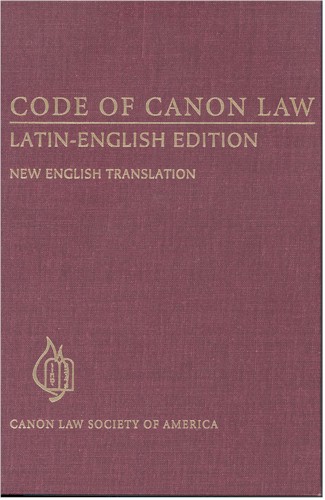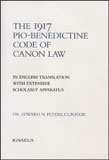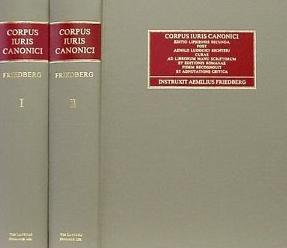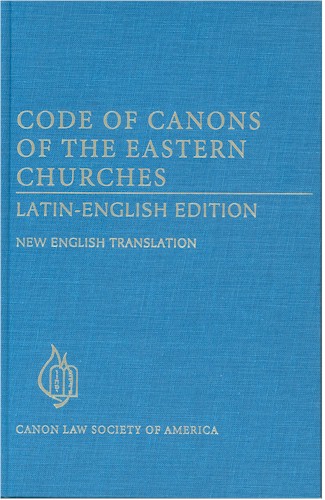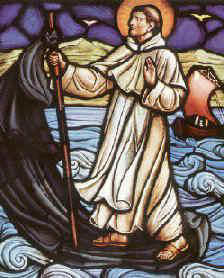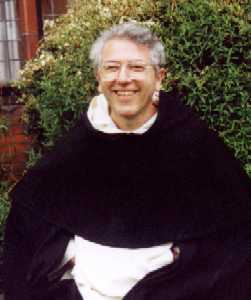|
To work for the proper implementation of canon law is to play an extraordinarily constructive role in continuing the redemptive mission of Christ. Pope John Paul II |
|
|
|
|
Resolution 1152 x 864 |
Updated 17 jan 2013 |
Review of the 1917 Code of Canon Law (2005) |
|
Paul Barber, in Ecclesiastical Law Journal, 25 (2004) 487-489.
|
The 1917 Pio-Benedictine Code of Canon Law is the first-ever English translation of the Codex Iuris Canonici of Pope Benedict XV to be published despite its having been abrogated as law since 1983. So has this book missed its mark by 18 years or is it aimed purely at the legal historian? I suggest that the answer to both these questions is no. Certainly legal historians will be interested in this book. In 1904, Pope Pius X commissioned the eminent canonist Pietro Cardinal Gasparri (1852-1934) to produce a distillation of what, over 1,500 years, had become a vast and confusing collection of canonical materials into a single and authoritative reference known as the Code of Canon Law. Its promulgation in 1917 by his successor Benedict XV was therefore a momentous event in the history of canon law, and [Peters’] volume earns its place in any canon law library on the strength of that alone. More importantly, however, canonists will know that canons cannot be fully understood without a study of their sources, and that an important source of many current canons are those of the 1917 Code. Indeed, the 1983 Code itself points this out in canon 21, containing in a rule of law which can be traced back to the Liber Sextus of Boniface VIII and the Digest: “…later laws are to be related to earlier ones and, as far as possible, harmonized with them”, whilst canon 6 re-states the importance of assessing canons in accord with canonical tradition. For this reason [Peters’] book performs a major service for all English-speaking canonists.
The book contains a translation of the [1917] Code, together with its Preface, the Apostolic Constitution promulgating it, and those of those of its original appendices that have not been completely superseded. In addition, the “extensive scholarly apparatus” described in the book’s subtitle consists of four extremely useful features. Above each canon a reference is given to the equivalent canon in the 1983 Code, where one exists, as well any relevant cross-reference within the 1917 Code. Below each canon is set out references to the volume and page number of each and every relevant reference to be found in the first ten volumes of the Canon Law Digest (covering 1917-1983). Finally, a footnote refers to every English-language doctoral dissertation discovered by Dr. Peters which has been written on the subject matter of that particular canon. Nearly 1,000 such dissertations are referred to, about half of which are from the published “Canon Law Studies” series of the Catholic University of America.
As one has come to expect from the Ignatius Press, this volume is handsomely presented, well typeset and solidly bound. A particularly nice touch is the collection of photographs at the front of the book, giving a human face not only to Popes Pius and Benedict and the Cardinal Gasparri, but also to the Code’s principle [English] commentators; Dom Augustine, Bouscaren & Ellis, Woywod & Smith, Jerome Hannon and James O’Conner.
The translation itself is a very literal one, and this, indeed, is a conscious and stated choice made by the editor. As this is a book whose principle purpose is to give English-speaking lawyers easier access to the authentic Latin text, this should not be a criticism, but it does mean that sometimes the English comes across somewhat clumsily. Dr. Peters also claims that he has “not permitted any so-called untranslatable Latin words or expressions to appear.” I am not altogether convinced that this laudable aim to communicate to the “masses not privileged to know Latin” always produces more clarity, nor does Dr. Peters in fact achieve his stated aim. Quite apart from his self-description on the title page as “curator”, the work contains numerous examples of Latin words, even where perfectly good equivalents exist in the English canonical tradition. So, for example, we still have “officialis” for “official”, “libellus” for “libel” and “ponens” (not to my knowledge an English word) is apparently untranslatable. On the other hand, rendering “ex officio” as “by office”, “septimae manus” as “seven-hand” and “nullius” as “of no one” in their respective contexts would appear to me to introduce more confusion than clarity for the uninitiated reader.
These, however, are minor irritations. More disappointing (although there may be good reasons for it) is the omission of the additional “scholarly apparatus” which would have rendered this work complete in itself, namely the Latin text itself, and the references to the “fonts” of each of the 1917 [Code] canons. Since the serious scholar must have recourse to these when studying the 1917 Code, it necessitates obtaining a long out-of-print Vatican text which then must be kept open simultaneously with Dr. Peters’ book.
[Barber's brief review of my Tabulae Congruentiae here]
I recently heard it suggested that Edward Peters was "the Roman Catholic Gerald Bray". In many ways this is true. Both have undertaken a momentous task which most of us would never wish to undertake ourselves, but are continuously grateful that someone else has already done it for us. Just as Professor Bray's collections allow us to trace the development of Anglican canons from their earliest sources through their attempted codification in the Reformatio Legum Ecclesiasticarum to the present day, Dr. Peters' two works allow us to do the same for the Latin Catholic Church from the law's first codification to the enactment of the current Code. These are important works which deserve a place in every canon lawyer's library.
|
|
Robert Ombres, op, in The Saint Austin Review (May 2002) =.
Ombres
A few thoughts occasioned by Barber's and Ombres' very gracious reviews of my book:
1) I might have over-estimated how much some Latin terms have entered English canonistics, though at least some suggestions (like "official" for "officialis") would have been misleading, too; more time will shed light on my translation choices, and might suggest revisions or reiteration.
2) The 1917 Codex is still in print and available from the Vatican.Including the Latin text would have greatly increased the size of my work, to say nothing of including Gasparri's invaluable fontes, albeit most of which point to sources available only in Latin. In any case, scholars will certainly want to follow Barber's good advice and keep the original Codex handy when using my translation thereof.
|
Even the physical appearance of many editions of the 1917 Code of Canon Law spoke of solidity and durability.
Pope Benedict XV Concluded the Apostolic Constitution attached to the Code by warning that no one should violate or rashly oppose in any way this document of his constitution, ordinance, limitation, suppression, derogation and expressed will. Should anyone attempt this, he would incur the wrath of Almighty God and of the Blessed Apostles Peter and Paul. In another document, the same Pope took steps to safeguard the Code's stability from the threat of frequent enactments of new laws. Yet, within a couple of generations, the 1917 Code had to be completely revised.
The promulgation of a Code in 1917
broke with canonical tradition to express and reinforce the
ecclesiology of its time. The twentieth century was the century of codification
for the Catholic Church, in imitation of Justinian and the secular codification
of many modern states. So there came about the first-ever Code
for the Latin Church in 1917, then
its full revision in 1983, and
finally the Code of Canons of the Eastern
Churches in 1990.
Not only is the 1983 Code significantly different in conception and content from its 1917 predecessor, but such is the pace of change even within the Church that the current Code looks less permanent. Already several important areas of canon law are to be found outside its pages.
The 1917 Code's air of stability was in part due to safeguarding its Latin text by strictly limiting translations into other languages. In this it was rather like the liturgy of the time. A good deal of canon law teaching and examining was conducted in Latin, largely by and for clerics, and rows of commentaries and studies were published in Latin. Since Vatican II, and because of the new needs of its revised ecclesiology and more broadly theology, not only has canon law changed but so has its presentation and accessibility.
Now that the 1917
Code has been abrogated, for the first time there is available a
complete English translation of it in one volume. Dr Edward Peters,
interestingly enough a Catholic layman trained in civil and canon law in the
United States, is to be congratulated for his superb achievement. Had he only
translated the 1917 Code into
English, it would have been cause enough for gratitude. All those with an
interest in reconstructing an important dimension of Catholic theology and life
from 1917 to Vatican II can now have
ready access in a widely known
contemporary language to the 1917 Code.
Those interested to canon law as such will now find it easier not only to understand the predecessor to the 1983 Code but also to see the lines of Continuity and discontinuity between the two canonical systems. Our juridical tradition will be less of a closed book. As well as a complete translation of the 1917 Code, Dr Peters has also helped us understand and use the codification, and he has retrieved a rich vein of scholarship in English. The bulk of Dr Peters' volume is of course the English translation of the 1917 Code and assorted documents and texts closely linked to it. The translation is on the whole reliable, literal and precise.
Dr Peters tells us in his introduction that he has not permitted any socalled "untranslatable" Latin words or expressions to appear. This is to avoid implying that some ecclesiastical, specifically juridical, concepts can never quite be explained to the mass of Catholics not privileged to know Latin. One wonders, in the light of this intention, why he has retained the term libellus (canons 1706 ff). The expression "a universe of cases", as found in canons 1588 and 1941, is odd. It is inconsistent to translate homo as "a man" in canon 87 and as "person" in canon 2241. To say "targeted by a penalty" (canon 542) is too colloquial, while the translation of canon 2219.3 is unclear. But such reservations are few and minor when measured against the quantity of successful translation.
As well as the translation, Dr Peters provides various helps to interpretation and understanding. Together with the text of each canon of the 1917 Code, there is a reference to the equivalent canon in the 1983 Code, quid citation of the place where official information on that canon was reported in the 10 volumes of the Canon Law Digest. If this were not enough, Dr Peters has placed in footnotes, at the appropriate places and according to information provided for him by various faculties of canon law, reference to almost 1000 scholarly works in English.
Dr Peters allows himself a brief reflection on researching the 1917 Code through the medium of the English language (pp. xxxi-xxxiv). He could well expand these few pages into an article, also considering the characteristics of English-speaking canonical writings and their specific cultural features. This would indicate the kind of reception universal canon law had in certain countries.
What he sketches is a panorama of canon law studies in English, even providing photographs of the key writers involved: Bachofen, Bouscaren, Ellis, Hannon, O'Connor, Smith and Woywod. It must be significant that all these writers worked in the United States. It may just be intriguing that, Hannon apart, they were all religious. The dominant role of the United States is in fact reflected on by Dr Peters, following his preliminary observation that there is more research material on the 1917 Code in English than in any other language except Latin.
Why this should be is perhaps surprising; it certainly surprised the author and this reviewer. By way of explanation, Dr Peters points to the fact that North America: was spared the chaos of two Continental wars during the lifetime of the 1917 Code; did not suffer the loss of large parts of its territory and resources to communist domination for nearly half a century; had superabundant ecclesiastical personnel; and possessed relatively extensive financial resources. All this, and there may have been other factors at work, fostered the formidable intellectual gifts of English-speaking scholars and canonists.
Dr Peters should now himself be included among the important contributors in English to the study of the 1917 Code. It is difficult to envisage his volume ever being replaced by that of a different author, although it might be amended in small ways in a future edition.
|
|
Robert Kennedy, FCS Quarterly 25/2 (Spring 2002), 36-38.
|
One gains a certain perspective on the antiquity and complexity of the Catholic Church through even a casual study of the history of canon law. At many different times and places the Church confronted concrete problems of all sorts and crafted responses as wisely as it could. Mindful of its position as the possessor of a body of revealed doctrine and a tradition of living out the implications of the doctrine, the Church assembled a collection of the canons, decrees, and legislative bits and pieces of councils and popes. By the middle of the twelfth century this collection included thousands of items but was disorganized and discordant. At that time, Gratian, a brilliant scholar of whose life we know little, organized the legal heritage of the first millennium of the Church’s history into a useful, coherent collection. Gratian’s Decretum became the foundation for canon law for the next millennium.
Additional collections followed, but irregularly and without the coherence of Gratian’s work. By the nineteenth century, the volumes of canon law were more a daunting reference library, requiring a great deal of patience and specialized knowledge, than a systematic body of law. Some laws had been abandoned, others were in conflict, and still others provoked questions about authenticity and authority. Bishops from around the world pleaded with the Holy See to do something to relieve them from the pastoral burden of laws piled upon laws.
In 1904 Pope St. Pius X responded to these pleas by creating a pontifical commission to organize the laws of the Church: to edit them for consistency, to arrange them in a clear and logical order, and to bring them up to date. The result was the first-ever codification of the laws of the Church, which was promulgated in 1917 and became effective the following year. The present volume is the first and only translation into English of the entire 1917 Code of Canon Law.
Since the 1917 Code has been supplanted by the revision of 1983, it is quite natural to ask why a translation of the earlier Code would appear now. Who should be interested in an 85-year-old, obsolete collection of laws. Clearly this is a volume that will not find its way into every Catholic home, nor even into the office of every Catholic theologian. Nevertheless, it is valuable and exceptionally well-done contribution to legal scholarship.
Translations of the entire 1917 Code have not appeared before because they were prohibited on the principle that translations from the governing Latin text would create confusion and conflicts in application. Furthermore, it was (wrongly) assumed that anyone who needed to consult the Code would be able to read the Latin without difficulty. This, of course, is no longer the case, and Peters' work has made the Code accessible to many who are not confident of their ability to manage the original.
Far from being merely the object of antiquarian interest, the 1917 Code is a particularly important movement in the history of the development of Church law. The current Code of Canon Law did not emerge full-grown from the minds of the commission charged with producing it. It is instead the latest refinement of one of the oldest possessions of the Church. If one genuinely wishes to understand the 1983 Code, it will often be necessary to investigate the origins of its provisions. The first step in such an investigation will usually be the 1917 Code.
Peters' translation is fluid, accurate, and eminently readable. He manages to preserve the clarity of the Code without falling into Latinisms that would distress modern readers. This alone would be worth the price of the text, but he provides much more.
Each article of the Code is cross-referenced in the text with other articles of the 1917 Code and with the 1983 Code. The reader is not forced to consult a cumbersome table to obtain references. Furthermore, Peters provides at each canon references to pertinent articles in the Canon Law Digest and dissertations from the schools of Canon Law in Washington, Ottawa, and Rome. Anyone who has attempted to research a topic in the law will immediately recognize how great a help this will be. Nor is this all the volume provides. Peters has provided a number of important collateral documents, such as the Apostolic Constitution promulgating the text and Cardinal Gasparri’s historical introduction.
Peters has done a fine job of translating and editing, and offered a quiet but very useful contribution to scholars who wish to understand better the mind of the Church in pastoral matters. There is no doubt that this will be the definitive English translation of the 1917 Code and that it will set a high standard for similar basic reference work in the future.
|
|
Russell Hittinger, First Things (Feb 2002) = |
Pope Pius X (1903-14) put into the hands of Pietro Cardinal Gasparri the task of organizing a single code of canon law. The 1917 Code of Canon Law was a groundbreaking work of legal art, for it distilled and organized some fifteen hundred years of canonical materials into 2,414 canons. It governed the Church for sixty-five years until it was replaced by the revised Code, promulgated in 1983 by Pope John Paul II. But the new Code requires attention to the older for understanding and applying the law. Along with the documents of the Second Vatican Council, the 1917 Code is an essential point of reference. This edition by Edward N. Peters is the first English translation of the 1917 Code. The translation is clean and sturdy. Most usefully, under each canon Peters provides cross-references to the new Code—which allows the reader to trace official developments of individual canons—as well as relevant secondary works and dissertations in English. This edition also includes the magisterial Preface by Cardinal Gasparri, which itself is worth the cost of the book.
|
